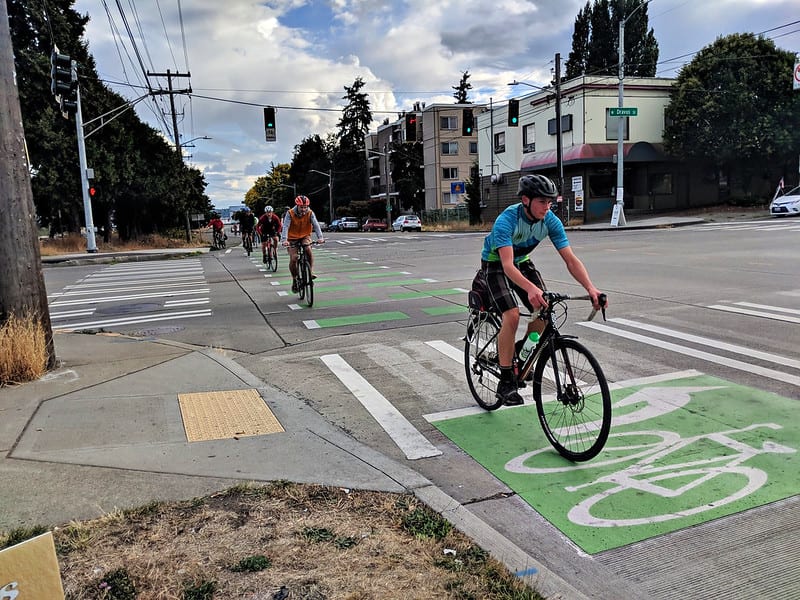 If a person biking approaches a stop sign - like this one in the University District - at a reasonably slow speed, they will now be able to treat it as a yield sign. Photo Credit: SDOT Flickr.
If a person biking approaches a stop sign - like this one in the University District - at a reasonably slow speed, they will now be able to treat it as a yield sign. Photo Credit: SDOT Flickr.Summary
- People biking must still fully stop at stoplights, stop signs on school buses, and stop signs at railroad crossings. This also doesn’t change the rules of the road for scooters.
- Research has shown that letting (and legalizing!) people biking to “take the lead” at intersections (which many already do) improves safety and may also improve intersection efficiency.
The Safety Stop bill (SB 6208) was signed into law by Governor Inslee on March 18, 2020, with bipartisan support following advocacy by the state’s bicycle community. The law goes into effect on Thursday, October 1, 2020.
The Safety Stop allows people biking to legally treat stop signs as yield signs when no other traffic is approaching and when they have slowed to a reasonable speed. Washington will be the fifth state to legalize these stops, joining Idaho, Delaware, Arkansas, and Oregon.

Under the new law, a bicycle (human powered or electric-assisted) approaching a stop sign may 1.) stop as normal, or 2.) treat it as a yield sign if:
- They have slowed to a reasonable speed, such that they could safely stop if needed, and
- They yield to any vehicle or pedestrian already in the intersection or with the right of way.
For everyone’s safety, people biking must still fully stop at:
- Stoplights, including stoplights in bike lanes
- Stop signs on school buses
- Stop signs at railroad crossings
This does not change the rules of the road for scooters. Although we’re excited to have recently re-added scooter share as part of our mobility toolkit – the law only specifies bicycles as eligible for Safety Stops.

Research has shown that letting (and legalizing!) people biking to “take the lead” at intersections (which many already do) improves safety and may also improve intersection efficiency.
A 2016 study from DePaul University recommended the Safety Stop to expand and improve biking as a transportation option. A 2010 study from UC Berkeley looked closely at cities in Idaho compared to those in states without the “Safety Stop” law.
The study found that cities with Safety Stop laws had 14.5% fewer bicycle injuries one year after adoption, and 30.4% better overall bicycle safety than similar cities.
That same study also detailed some benefits and rationale for the Safety Stop:
- Reduced confusion and fewer collisions: People biking who stop at stop signs have said driver confusion about right of way increases the risk of collisions. It also leads drivers to give people biking the right of way improperly, creating awkward delays and additional collision risks. The Safety Stop law reduces this confusion.
- Reduced exposure to air pollution: Air pollution is generally highest at intersections, and allowing people biking to clear the intersections faster reduces their exposure.
- Reduced overuse injury: People biking may experience a higher risk of strain and overuse injuries from consistent stopping and re-starting.

Read more about biking in and around Seattle.
"Stop" - Google News
October 01, 2020 at 06:00AM
https://ift.tt/3ihWEom
Washington's new “Safety Stop” law allows people biking to treat stops signs as yield signs w/ exceptions. - seattle.gov
"Stop" - Google News
https://ift.tt/2KQiYae
https://ift.tt/2WhNuz0
Bagikan Berita Ini















0 Response to "Washington's new “Safety Stop” law allows people biking to treat stops signs as yield signs w/ exceptions. - seattle.gov"
Post a Comment